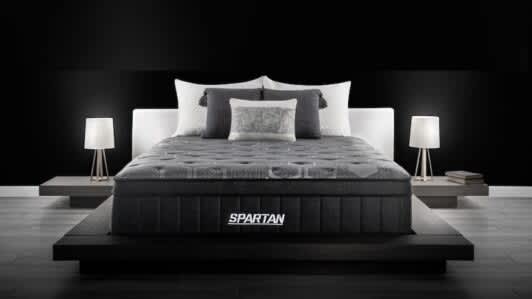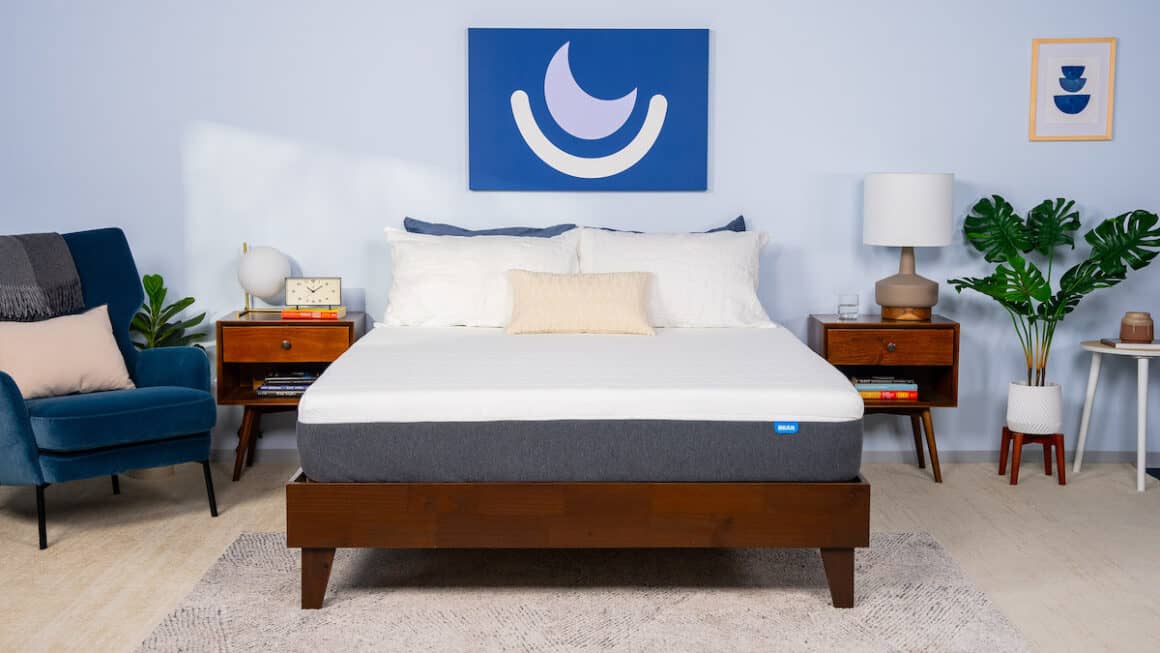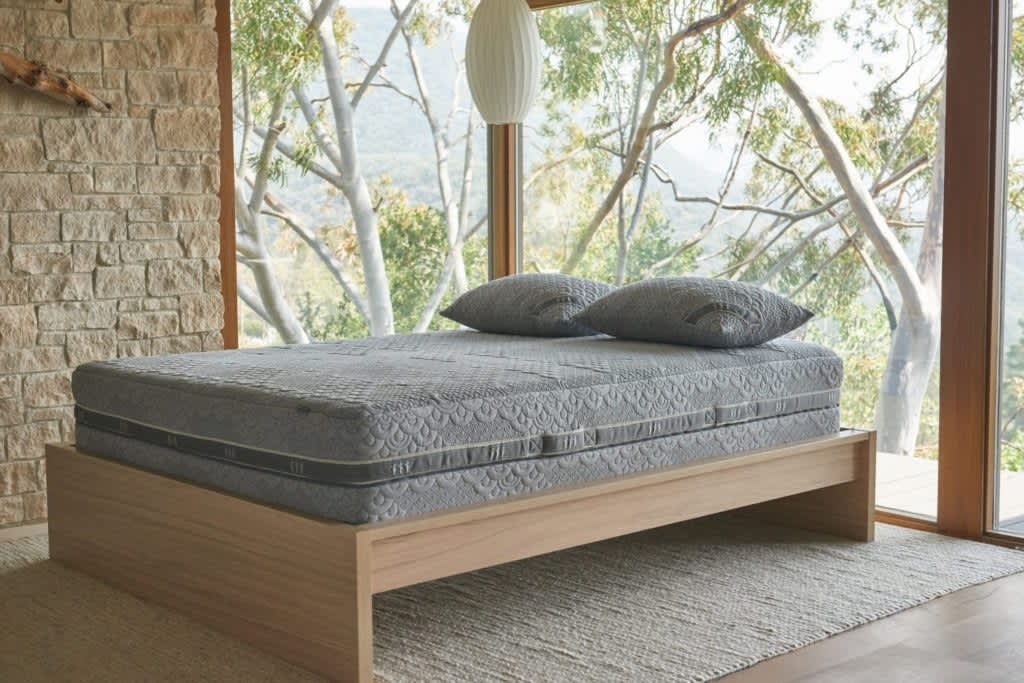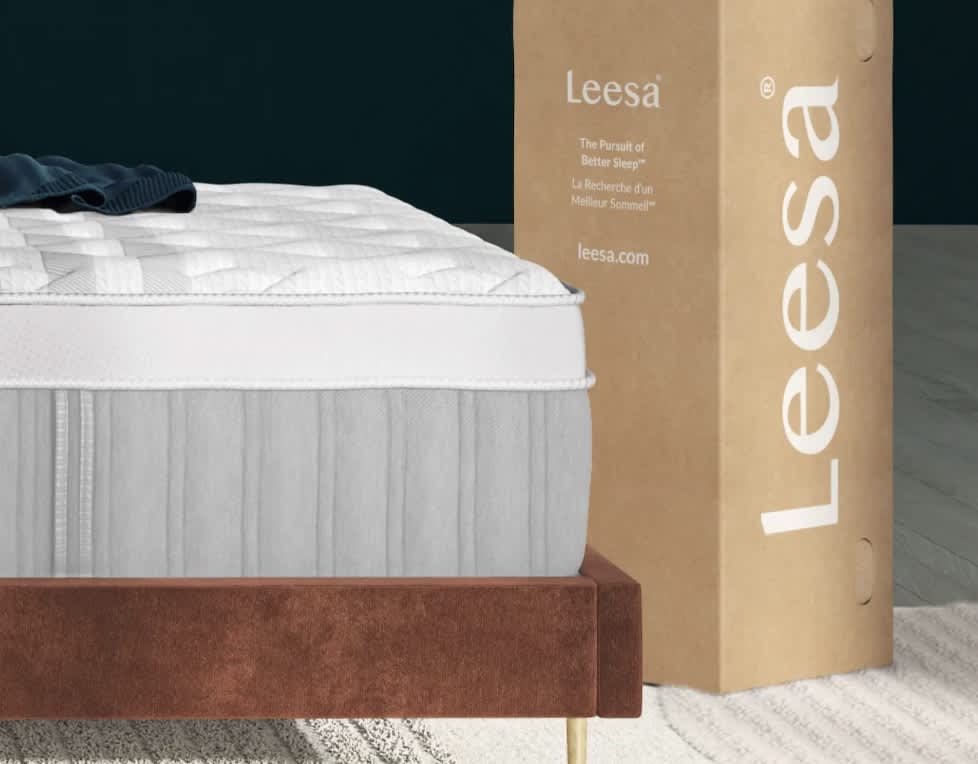On This Page
The Best Mattress for Athletes
Our Top Picks
-
Best Overall Mattress
Brooklyn Bedding Spartan Hybrid Essential -
Best Value Mattress
Bear Original -
Most Comfortable Mattress
Brentwood Home Crystal Cove -
Best Luxury Mattress
Loom & Leaf -
Best Mattress for Side Sleepers
Nectar Mattress -
Best Cooling Mattress
Leesa Sapira Chill Hybrid
Best Overall Mattress

The Brooklyn Bedding Spartan Hybrid Essential is a thick hybrid mattress that offers an excellent balance of pressure relief and support. We found the construction caters to athletes by easing pressure off achy joints while maintaining strong spinal alignment.
Pros & Cons
Pros
- Hybrid design and cooling technology help keep sleepers from overheating
- Strong edge support makes it easier to get in and out of bed
- Zoned support system relieves pressure while keeping the spine aligned
Cons
- Foam comfort system doesn’t completely isolate motion
- 13-inch profile may require deep pocket sheets
Ratings
Our Take
Best Value Mattress

The Bear Original offers excellent contouring and pressure relief for sleepers with active lifestyles, but it stands apart from other all-foam models with a noticeably firmer feel. The price-point is also lower than average, which we think will appeal to shoppers on a budget.
Pros & Cons
Pros
- Excellent option for those who want a firm bed that also relieves pressure
- Foam construction prevents motion transfer
- Very competitive price-point
Cons
- Edges compress significantly with weight
- Doesn’t sleep particularly cool
Ratings
Our Take
Most Comfortable Mattress

The Brentwood Home Crystal Cove is a hybrid mattress with a flippable design offering a different firmness level on each side. We found the unique construction makes this bed comfortable for an impressive range of sleepers across all body types and sleep positions.
Pros & Cons
Pros
- Flippable design lets sleepers swap between medium soft and medium firm feels
- Robust edge support gives sleepers plenty of space to sprawl out
- Excellent ease of movement on the firmer side
Cons
- Sleep surface is too conforming for stomach sleepers over 130 pounds
- Neither side has enough support for people over 230 pounds
Ratings
Our Take
Best Luxury Mattress

The Loom & Leaf is an all-foam model with a more sophisticated design than other foam beds we’ve tested. The foam is zoned to enhance lumbar support, plus you can choose between a medium firm (6) or firm (8) transitional layer. It’s perfect for sleepers who enjoy firmer foam.
Pros & Cons
Pros
- Dedicated lumbar support system
- Available in medium firm and firm feels
- Memory foam closely conforms to the body’s shape to absorb impact and relieve pressure
Cons
- Strong chemical-like smell when unboxed
- Limited edge support
Ratings
Our Take
Best Mattress for Side Sleepers
The all-foam design of the Nectar Mattress is perfect for cushioning your shoulders, hips, and other areas prone to painful pressure buildup. The above-average firmness helps support your lumbar region better than other foam models we’ve tested.
Pros & Cons
Pros
- Top-notch motion isolation thanks to thick foam layers
- Competitive price-point
- Blend of pressure relief and spinal support that excels for side and back sleepers under 230 pounds
Cons
- Not ideal for sleepers who dislike a deeply contouring feel
- Stomach sleepers over 230 pounds may need more support
Ratings
Our Take
Best Cooling Mattress

Thanks to its excellent cooling and temperature control, the Leesa Sapira Chill stands out from many other foam hybrids. Open-cell foams resist heat buildup to maintain a comfortable surface, while the coils promote plenty of airflow throughout the interior.
Pros & Cons
Pros
- Deep cushioning with four individual foam layers
- Zoned coils provide extra midsection support
- Three firmness options
Cons
- High-profile requires a deep-pocket fitted sheet
- Strong initial off-gassing for up to 72 hours after delivery date
Ratings
Our Take
Compare Our Top Picks
| Mattress | Mattress Type | Ideal For | Value | Sleep Trial |
| Brooklyn Bedding Spartan Hybrid Essential | Hybrid | Combination Sleepers | Great Value | 120 nights (30-night requirement) |
| Bear Original | Foam | Side and Back Sleepers | Great Value | 120 nights (30-night break-in period) |
| Brentwood Home Crystal Cove | Hybrid | People With Back Pain | Good Value | 365 nights (30-night requirement) |
| Loom & Leaf | Foam | Side Sleepers | Good Value | 365 Nights ($99 Return Fee) |
| Nectar Mattress | Foam | Side Sleepers | Great Value | 365 nights |
| Leesa Sapira Chill Hybrid | Hybrid | Couples | Good Value | 100 nights (30 night requirement) |
Many athletes tend to gravitate towards mattress models designed with recovery in mind. Features like cooling technology to prevent heat retention and memory foam comfort layers to relieve pressure buildup are especially appreciated by athletes looking to get quality rest so they can perform their best.
What to Consider in a Mattress for Athletes
Mattress shopping for an athlete starts with narrowing your search down to essential needs and then expanding into qualities you may want. We suggest focusing first on construction type, firmness level, size, and overall feel.
Mattress Type
Mattress components and configurations vary widely. However, most models fall within one of the five most popular mattress types.
- Foam: Foam mattresses can be excellent for athletes who experience pressure points or joint pain. They can include polyfoam, memory foam, or both, and they typically provide deep cushioning and a hugging sensation.
- Innerspring/Hybrid: Innerspring and hybrid mattresses both have responsive support cores made from coils. They generally have significant pushback, plenty of structure, and often sleep cool. While traditional innerspring models have just a thin layer of padding atop the coils, hybrids generally have thicker comfort layers made from foam, latex, microcoils, or other cushioning materials.
- Latex: Made from rubber tree sap, natural latex has a buoyant feel. It’s an excellent pressure reliever and is one of the most durable mattress materials. Athletes who weigh more than 230 pounds and those needing pressure relief without significant compression may enjoy a latex mattress.
- Airbed: An airbed has an air chamber support core that lets you change the bed’s firmness level with a remote control or app. While expensive, airbeds are highly versatile and worthwhile for athletes who want to adjust their bed’s feel to match their training and recovery needs.
Pressure Relief
Pressure-relieving mattresses adapt to the sleeper’s unique shape. Materials like memory foam, polyfoam, and latex absorb impact and help distribute weight, which minimizes how much pressure builds up beneath heavier areas like the hips, shoulders, and midsection. A pressure-relieving mattress may help alleviate athletes’ sore muscles and joints while encouraging recovery.
Cooling Technology
If you’ve already generated heat through a workout, going to sleep on a hot mattress can be uncomfortable. Athletes can avoid this by seeking out temperature-regulating mattresses and materials that promote cooling.
Hybrid, innerspring, and latex mattresses generally sleep cooler than all-foam models. However, some foams use materials designed to combat this issue.
Certain cooling features like Celliant fiber and phase change material are engineered to absorb and disperse the body’s heat. Gel and copper foam infusions are also designed to decrease heat retention.
How to Choose the Right Firmness Level for Athletes
Although some mattress manufacturers may want you to think otherwise, there is no one perfect firmness level that works for everyone. Body weight and sleeping position affect how much structure you need to keep your spine properly supported.
Side sleepers tend to prefer softer mattresses that cushion their hips and shoulders. Stomach sleepers generally need firmer support to keep the midsection on an even plane, while back sleepers often like a mid-range feel.
Body weight is also important to consider because weight affects how deeply you compress a mattress. For athletes, it’s especially critical to get a mattress that matches their weight and sleeper type. One that’s too soft can allow the spine to become misaligned, placing strain on the lower back and neck. A model that’s too firm won’t provide enough cushioning to prevent pressure points from developing.
We use a 10-point scale to measure mattress firmness. The lower the number, the softer a mattress feels. While your individual needs may vary, we’ve found that the following comfort preferences tend to be popular.
| Weight | Side Sleepers | Back Sleepers | Stomach Sleepers |
| Less than 130 lbs. | Soft (3) to Medium (5) | Soft (3) to Medium (5) | Medium Soft (4) to Medium Firm (6) |
| 130 to 230 lbs. | Medium Soft (4) to Medium (5) | Medium (5) to Firm (7) | Medium (5) to Firm (7) |
| More than 230 lbs. | Medium Firm (6) to Firm (7) | Firm (7-8) to Extra Firm (9) | Firm (7-8) to Extra Firm (9) |
How Sleep Impacts Athletic Performance
While sleep is important for everyone, it’s especially critical for athletes, since studies have found that high-quality sleep can reduce injury risk and enhance athletic performance and recovery. Research also shows that when athletes get enough sleep, they have better reaction time, strength, and endurance.
Sleep Improvement Tips for Optimal Performance
Improving your sleep quality takes attention and dedication. Even small, incremental steps toward better sleep can make a significant difference.
Practice Good Sleep Hygiene
Creating good bedtime habits can improve your sleep hygiene and may result in longer and better sleep. Best practices include:
- Sticking to a consistent schedule and regular bedtime routine
- Avoiding electronic devices before bed
- Not drinking caffeine late in the day
- Abstaining from alcohol before bed
- Winding down by doing yoga, reading, or listening to calming music
Upgrade Your Bedding
Swapping out your existing bedding for a more comfortable and cozy setup is an easy fix if you want a more inviting sleep environment. Hot sleepers can opt for sheets and blankets made from breathable materials like cotton, linen, or bamboo-derived fabrics. Investing in sheets with a different weave is also an easy way to change your bed’s feel.
Invest in a Supportive Topper
If you want to adjust the feel of your sleep surface but aren’t ready to buy a new mattress, you can try a mattress topper. Toppers can be quite affordable and come in a range of materials, including foam, latex, and wool.
Athletes looking to change their mattress’ firmness level can use a topper that’s firmer or softer than their current bed. Toppers with zoned comfort systems may promote spinal alignment and alleviate pressure points, which are often important factors for athletes.
Use Pillows for Added Support
Athletes may find increased support and comfort by using pillows strategically and according to their sleep position and body type. A long body pillow is an excellent option for side sleepers who want to take pressure off their hips and knees, while a thin pillow under the midsection can prevent a stomach sleeper’s spine from curving.
Video: How Sleep Affects Performance
Watch as the Sleep Doctor explores what it means to sleep well and the physical and mental upsides of sleep.
Discover More Mattress Solutions
In this guide, we aimed for a broad selection of top mattress picks geared toward athletes with varying sleep needs. If you’ve decided which style of mattress you want but need more options, check out our testing team’s picks organized by mattress type.
Best Mattresses by Type
How We Test
Our team has testers representing every weight group and sleeper type. In addition to trying each mattress in person to get our testers’ subjective takes, we also put them through the same series of tests to see how they compare.
To choose the best mattresses for athletes, we paid special attention to performance factors like the ability to effectively relieve pressure, regulate temperature, and support the spine.
Frequently Asked Questions
A memory foam mattress may be a good choice for an athlete seeking deep cushioning and pressure point prevention. Memory foam hugs the body and molds to its unique shape, which helps to absorb impact on joints and muscles. A heavier athlete may prefer a bed with a firmer feel and coil-based support, such as one of the best hybrid mattresses.
For athletes who weigh over 230 pounds, a firm mattress is typically a better choice than a soft model, though this isn’t a hard and fast rule. How much you weigh, your favorite sleeping position, and your personal preferences all affect which firmness level you should choose.
Experts recommend that adults should get at least seven hours of sleep per night. Certain athletes may need more sleep, though. A study involving elite athletes across a variety of physically demanding sports — including basketball, soccer, swimming, and cycling — showed that the athletes required an average of eight to nine hours of sleep to feel rested.
The best mattress size for an athlete depends on their height, weight, and bedroom size. Space permitting, taller athletes may prefer a California king mattress, which is 4 inches longer than a queen or a king. Athletes over 230 pounds may like a mattress that’s at least 10 inches thick so that they don’t sink through the comfort layers and feel the underlying support core.
